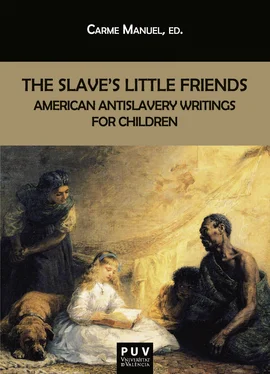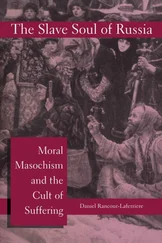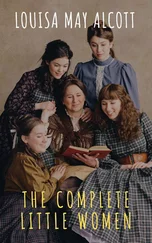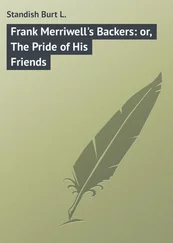Jonathan Walker’s A PICTURE OF SLAVERY FOR YOUTH(184[?]) was published after 1845 and the picture of his branded hand is one of the most publicized of the visual archive generated by abolition. Robin Bernstein explains (103) that “the ultimate impression of slavery is the burn-wound, the brand.” Walker (1799-1878), a captain of a fishing vessel and an antislavery activist, was condemned as a slave stealer by a Southern court after unsuccessfully trying to transport seven fugitive slaves from Florida to the British West Indies in 1844. After a year in jail, he was sentenced to “a fine, an hour in the pillory, and, in a most unusual punishment, he was branded with the letters ‘SS’—slave stealer—below the thumb of his right hand” (Bernstein 103). After this incident, Walker became an antislavery speaker. John Greenleaf Whittier wrote a 52-line poem celebrating his heroic feat titled “The Man with the Branded Hand,” a name by which he became known in national antislavery circles after reading the pamphlet that the Anti-Slavery Office in Boston published in 1845 titled Trial and Imprisonment of Jonathan Walker, at Pensacola, Florida, for Aiding Slaves to Escape from Bondage. With an Appendix Containing a Sketch of His Life , with a Preface by Maria Weston Chapman. Walker wrote countless articles for William Lloyd Garrison’s The Liberator , and lectured for the next seven years on the issue of slavery throughout New England. After his autobiographical account of his trial and imprisonment, he published A Brief View of American Chattelized Humanity and Its Supports (1846).
Whittier immortalized Walker’s deed in the often reprinted lines 41-42 of his poem: “Then lift that manly right hand, bold ploughman of the wave! / Its branded palm shall prophesy, ‘Salvation to the Slave!’” Harriet Beecher Stowe also paid homage to Walker’s branded hand in Uncle Tom’s Cabin when she also had her heroic fugitive George Harris’s hand branded. In fact, Walker’s image of his branded hand was daguerreotyped and later turned into a woodcut illustration. He was instrumental in transforming his wound into an abolitionist symbol not only by writing his story but, more important, by “disseminating mass-reproduced images of his hand in broadsides, periodicals, and children’s books, where the image was often accompanied by John Greenleaf Whittier’s ballad, ‘The Branded Hand’” (Bernstein 103). Taking Marcus Wood’s coinage, the picture of Walker’s branded hand, mass-produced by the thousand and distributed in countless manifold printed media, was aimed at the “hagiographic construction” of Walker as a white champion of abolition (2000: 8). Yet, as Wood writes (2013: 238), “[i]ronically, this cauterized hand was the most widely marketed image of branded flesh to come out of the Atlantic slavery.”
In the Preface to A Picture of Slavery for Youth , Walker wrote about how his devotion to the welfare of the slaves and to others “who are degraded and oppressed” urged him to pen his text, “hoping they will be the means of awakening many to just thoughts, feelings and conduct, in relation to the system of slavery in these UNITED STATES.” Some pictures of his text were taken from George Bourne’s Picture of Slavery in the United States of America (Middletown, Connecticut: Edwin Hunt, 1834), with wood engravings designed by H.A. Munson and G.W. Flagg; and Slavery Illustrated in Its Effects Upon Woman’s Domestic Society (Boston: Isaac Knapp, 1837), both books were republished several times throughout the 1830s. Bourne was a radical abolitionist who called for the “immediate emancipation without compensation” of American slaves. His two books sought to represent slavery visually, without the direct testimony of the formerly enslaved eyewitness, and thus rely on graphically written descriptions and woodcut illustrations of the tortures endured by slaves to impress upon his readers the horrors of enslavement in the U.S. South. In Picture of Slavery , Bourne wrote: “The engravings illustrate slavery as it may be seen in its various degrees of turpitude, among all classes of American man-stealers, whether they are avowed infidels, or nominal Christians” (7). As Teresa Goddu explains, “[b]y painting the horrors of the slave plantation as a gothic scene of unending cruelty, Bourne exposes the truth beneath the South’s polite veneer and constructs slavery as a sin against God as well as a crime against humanity. Bourne uses the gothic to render slavery socially unacceptable: readers are asked to recoil from slavery’s ‘odious wickedness (Bourne 122) and to censure its villains’ ‘enormous crimes’ (Bourne 44).” Moreover, the abolitionist “deploys the gothic’s affective register of dread and terror to create a response of revulsion in the face of slavery’s debasing acts” (2016: 38). These illustrations, together with the explicit descriptions of cruelties perpetrated against the enslaved and real newspaper advertisements of slaves for sale, worked to leave nothing to the imagination of the child readers of the book. As Joe Richardson states, “[c]ertainly his method of combining advertisements, comments, and pictures must have created indignation in many a youth.” Readers of A Picture of Slavery for Youth were adamantly “implored to make slavery their cause” (lxxviii). As he highlighted in his Preface, Walker wanted to impress the minds of the young, since their impressions were tightly “connected with the destinies of the future.”
Post-Uncle Tom’s abolitionist writings for children
The appearance of Harriet Beecher Stowe’s Uncle Tom’s Cabin in 1851/52—the most important book to portray slavery in the United States—signaled a turning point in American antislavery writings and, consequently, in abolitionist writings for children. The phenomenal reception of the novel “confirmed that sentimental images of children and families were especially effective in helping antebellum America feel for the nation’s slaves” (De Schweinitz 15).
PICTURES AND STORIES FROM UNCLE TOM’S CABINstands as an early transformation of Stowe’s novel into a children’s book. The volume, published by John P. Jewett in United States and T. Nelson and Sons in London in January 1853, less than a year after the novel appeared, shows the strategies used to conform the text to a juvenile audience, and how the highly political content was sugar-coated both textually and visually to present a palatable antislavery agenda. In contrast to previous radical abolitionist texts for children, Stowe’s adaptation of her novel appeared cloaked with an antislavery cultural and political capital that afforded the book the possibility to enter a wider circle of American middle-class homes, previously out of bounds to polarized antislavery narratives. The book is “a well-constructed text,” with “[t]houghtful transitions and deft elaborations,” which “create a tightly woven narrative that reads smoothly, despite massive cuts” (Hochman 105). Barbara Hochman considers that Pictures and Stories is an important version that appealed to children, “in part because the book violated widely shared conventions for antebellum children’s reading” (105). The introductory page states the didactic aims of the text as a morally enlightened writing for children that aims to encourage a compelling sense of sympathy for the social outcasts: “This little work is designed to adapt Mrs. Stowe’s touching narrative to the understanding of the youngest readers and to foster in their hearts a generous sympathy for the wronged negro race of America.” Then, on the following page, the editor explains what the abridgement and simplification of the text has entailed. Firstly, it declares the aim of the adaption, the active participation of Stowe herself in rewriting some parts of the content in verse and the typographic traits established to facilitate the reading of these poems by the youngest readers, as well as the attempt to engage the collaboration of the older members of the family for the prose parts written in smaller type: “The purpose of the Editor of this little Work, has been to adapt it for the juvenile family circle. The verses have accordingly been written by the Authoress for the capacity of the youngest readers, and have been printed in a large bold type. The prose parts of the book, which are well suited for being read aloud in the family circle, are printed in a smaller type, and it is presumed that in these our younger friends will claim the assistance of their older brothers or sisters, or appeal to the ready aid of their mamma.”
Читать дальше












